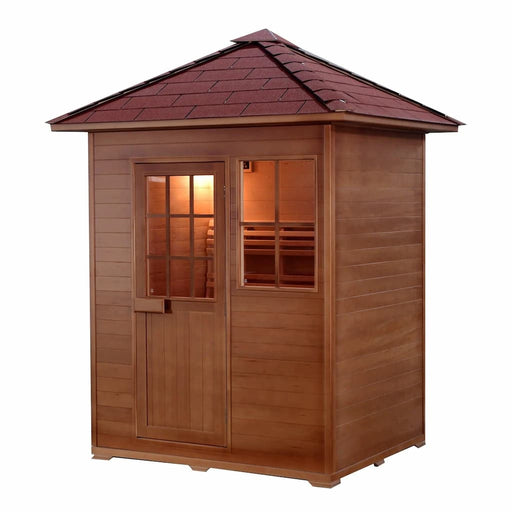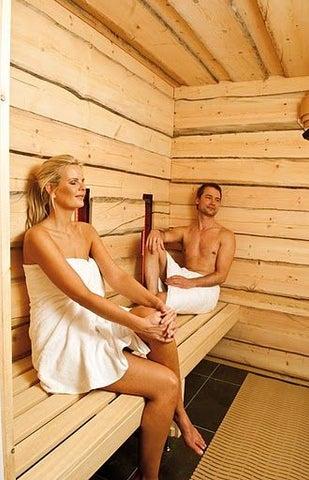Traditional Sauna Fundamentals Explained
Traditional Sauna Fundamentals Explained
Blog Article
The 9-Minute Rule for Traditional Sauna
Table of ContentsExcitement About Traditional SaunaOur Traditional Sauna IdeasTraditional Sauna Can Be Fun For EveryoneFascination About Traditional Sauna
A lot of the weight shed in a sauna is water loss and is re-gained upon rehydrating. Without a question sauna can be a vital part of a healthy weight loss program. To look at the distinctions between typical and IR saunas, I will certainly separate these into proven, academic, and fabricated distinctions.Thus, the best factor in the saunawhich is at the ceiling directly over the sauna heateris usually in between 185 and 190 F. Traditional Sauna. Claims that a traditional sauna exceeds 200 F is merely not true and not applicable for electrical saunas offered in the United States. The temperature level for a far-infrared sauna is generally set between 120 and 140 F; however, unlike the traditional sauna, the goal in and IR area is not to accomplish a heat
As a result of this, the temperature difference is nearly irrelevant, considering that extreme sweating results in both sauna types, however the technique of heating the body is various. In an IR sauna the bather will really feel hot and will certainly sweat profusely, however at a lot reduced temperature levels. Hence, if the goal is to spend longer amount of times in the sauna, the IR sauna is a great choice.

Facts About Traditional Sauna Uncovered
When the high temperature level is attained, the aspects cycle on and off to keep the high temperature level. Many traditional sauna individuals enjoy pouring water over the rocks to create steam to raise sauna moisture degrees. The advantages of putting water over the rocks include: making the area much more comfy, moistening the nasal passages, and permitting the use of aromatherapy by blending essential oils with the water.
In a far-infrared sauna, the warmth waves penetrate the body to successfully heat up the body and raise the body core temperature. To attain this increased temperature level, Far-infrared emitters create infrared power which is close to Discover More Here the exact same wavelength as that which the body normally emitsoften described as the "Important Variety" of 7 to 14 microns), so the energy is well gotten by the body.
When the power goes into the body, it creates the body temperature level to boost and inevitably results in sweating. In an infrared sauna it's important for the emitters/heaters to remain on practically frequently. Given that there is no mass of rocks to preserve heat, the sauna will cool down if the emitters turned off.
As mentioned over, the sauna bather in an infrared area desires to position himself in front of operating emitters to get maximum gain from the heat. The home heating time for the two rooms can be extremely different, depending on exactly how the areas are utilized. For a typical sauna, a bather ought to permit 30-40 mins for the room to accomplish a wanted temperature and to correctly pre-heat the rocks.
Not known Factual Statements About Traditional Sauna
A well constructed sauna will typically achieve a temperature of 150-160 F in regarding 30-40 mins. For hotter temperatures, the room may require to warmth for a longer duration.
To some, 15 minutes was "squandered" while the infrared energy warmed the timber panels instead than warming a body, while others discover a pre-heated room to be more comfortable and believe an elevated beginning temperature level is required to start sweating. The size of suggested usage for each and every area is approximately the exact same (10-15 mins per session); nevertheless, due to the lower air temperatures and the ability to really feel the impacts of infrared warmth quicker than a typical sauna, it is not unusual for an individual to invest a total of 20-30 mins in an infrared sauna.
Typical saunas often tend to be larger (thus make use of even more electrical energy) than infrared saunas, although typical saunas are absolutely offered in one and two person sizes. For a two-person conventional sauna, 5x6 or 5x7 dimension is most preferred. The top bench can conveniently seat 2 or three individuals and is likewise enough time to relax throughout the sauna session.


The average price per kWH of electricity in the united state is roughly $0.11, so a 4.5 kW heating system will set you back roughly $.50 to compete one hour, if the heating unit runs continually for one hour. Typically a sauna heater will certainly run for 75% of the initial hour and 50% of subsequent hours on considering that the aspects cycle once the set temperature level is achieved.
Not known Facts About Traditional Sauna
A two person far-infrared area is typically literally smaller sized than a standard sauna, typically concerning 4' x 4' or smaller sized. The IR heating unit is normally 1.5-1.7 kW utilizing a 120 volt 15 amp plug-in next solution. Given that the visit this website space can be utilized quicker than a sauna area, we will think the space is utilized for to of an hour including warm up time.
Finally, there is a rarely reviewed distinction in the social experience in between both areas. While our culture has lost some of the social benefit of the conventional sauna experience, it can be very socially gratifying. From family members time in the sauna, to heart-felt discussions with better halves, to sauna partiesthe typical sauna experience can lead to intimate socializing.
Many higher end infrared areas include tinted light therapy, audio systems and full-glass fronts.
Report this page